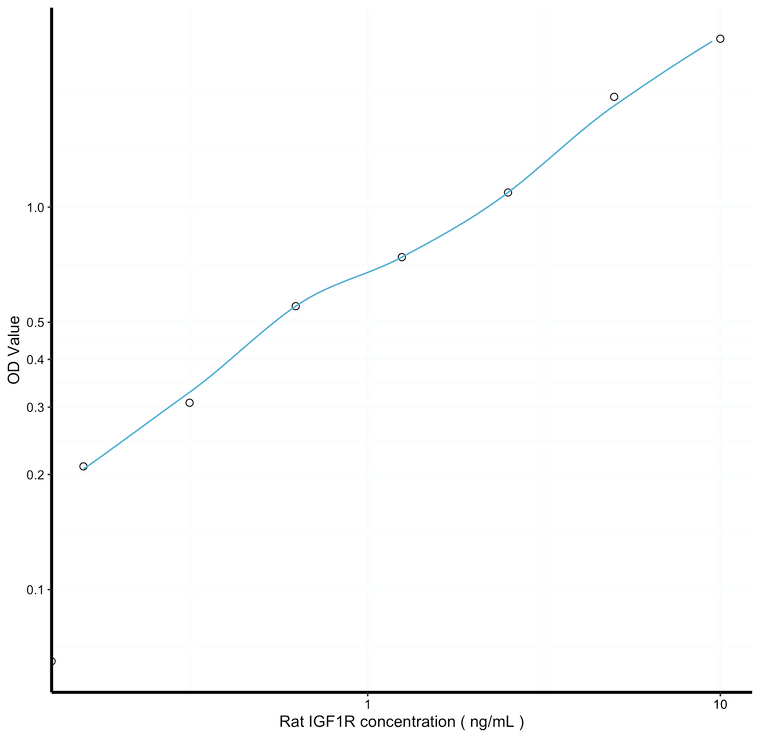| Applications: |
ELISA |
| Reactivity: |
Rat |
| Note: |
STRICTLY FOR FURTHER SCIENTIFIC RESEARCH USE ONLY (RUO). MUST NOT TO BE USED IN DIAGNOSTIC OR THERAPEUTIC APPLICATIONS. |
| Sensitivity: |
0.062ng/mL |
| Detection Limit: |
0.156-10ng/mL |
| Short Description: |
This IGF1R Sandwich ELISA Kit is an in-vitro enzyme-linked immunosorbent assay for the measurement of samples in rat cell culture supernatant, serum and plasma (EDTA, citrate, heparin). |
| Storage Instruction: |
Store the unopened kit in the fridge at 2-8°C for up to 6 months. Once opened store individual kit contents according to components table provided with the kit. |
| Assay Time: |
4.5 hrs |
| Gene Symbol: |
Igf1r |
| Gene ID: |
25718 |
| Uniprot ID: |
IGF1R_RAT |
| Sample Type: |
tissue homogenates, cell lysates or other biological fluids. |
| Tissue Specificity | |
| Post Translational Modifications | Autophosphorylated on tyrosine residues in response to ligand binding. Autophosphorylation occurs in trans, i.e. one subunit of the dimeric receptor phosphorylates tyrosine residues on the other subunit. Autophosphorylation occurs in a sequential manner.Tyr-1166 is predominantly phosphorylated first, followed by phosphorylation of Tyr-1162 and Tyr-1167. While every single phosphorylation increases kinase activity, all three tyrosine residues in the kinase activation loop (Tyr-1162, Tyr-1166 and Tyr-1167) have to be phosphorylated for optimal activity. Can be autophosphorylated at additional tyrosine residues (in vitro). Autophosphorylated is followed by phosphorylation of juxtamembrane tyrosines and C-terminal serines. Phosphorylation of Tyr-981 is required for IRS1- and SHC1-binding. Phosphorylation of Ser-1279 by GSK-3beta restrains kinase activity and promotes cell surface expression, it requires a priming phosphorylation at Ser-1283. Dephosphorylated by PTPN1. Polyubiquitinated at Lys-1169 and Lys-1172 through both 'Lys-48' and 'Lys-29' linkages, promoting receptor endocytosis and subsequent degradation by the proteasome. Ubiquitination is facilitated by pre-existing phosphorylation. Sumoylated with SUMO1. Controlled by regulated intramembrane proteolysis (RIP). Undergoes metalloprotease-dependent constitutive ectodomain shedding to produce a membrane-anchored 52 kDa C-Terminal fragment which is further processed by presenilin gamma-secretase to yield an intracellular 50 kDa fragment. |
| Function | Receptor tyrosine kinase which mediates actions of insulin-like growth factor 1 (IGF1). Binds IGF1 with high affinity and IGF2 and insulin (INS) with a lower affinity. The activated IGF1R is involved in cell growth and survival control. IGF1R is crucial for tumor transformation and survival of malignant cell. Ligand binding activates the receptor kinase, leading to receptor autophosphorylation, and tyrosines phosphorylation of multiple substrates, that function as signaling adapter proteins including, the insulin-receptor substrates (IRS1/2), Shc and 14-3-3 proteins. Phosphorylation of IRSs proteins lead to the activation of two main signaling pathways: the PI3K-AKT/PKB pathway and the Ras-MAPK pathway. The result of activating the MAPK pathway is increased cellular proliferation, whereas activating the PI3K pathway inhibits apoptosis and stimulates protein synthesis. Phosphorylated IRS1 can activate the 85 kDa regulatory subunit of PI3K (PIK3R1), leading to activation of several downstream substrates, including protein AKT/PKB. AKT phosphorylation, in turn, enhances protein synthesis through mTOR activation and triggers the antiapoptotic effects of IGFIR through phosphorylation and inactivation of BAD. In parallel to PI3K-driven signaling, recruitment of Grb2/SOS by phosphorylated IRS1 or Shc leads to recruitment of Ras and activation of the ras-MAPK pathway. In addition to these two main signaling pathways IGF1R signals also through the Janus kinase/signal transducer and activator of transcription pathway (JAK/STAT). Phosphorylation of JAK proteins can lead to phosphorylation/activation of signal transducers and activators of transcription (STAT) proteins. In particular activation of STAT3, may be essential for the transforming activity of IGF1R. The JAK/STAT pathway activates gene transcription and may be responsible for the transforming activity. JNK kinases can also be activated by the IGF1R. IGF1 exerts inhibiting activities on JNK activation via phosphorylation and inhibition of MAP3K5/ASK1, which is able to directly associate with the IGF1R. When present in a hybrid receptor with INSR, binds IGF1. |
| Protein Name | Insulin-Like Growth Factor 1 ReceptorInsulin-Like Growth Factor I ReceptorIgf-I ReceptorCd Antigen Cd221 Cleaved Into - Insulin-Like Growth Factor 1 Receptor Alpha Chain - Insulin-Like Growth Factor 1 Receptor Beta Chain |
| Database Links | Reactome: R-RNO-2404192Reactome: -RNO-2428928Reactome: -RNO-2428933Reactome: -RNO-9009391 |
| Cellular Localisation | Cell MembraneSingle-Pass Type I Membrane Protein |
| Alternative ELISA Names | Insulin-Like Growth Factor 1 Receptor ELISA kitInsulin-Like Growth Factor I Receptor ELISA kitIgf-I Receptor ELISA kitCd Antigen Cd221 Cleaved Into - Insulin-Like Growth Factor 1 Receptor Alpha Chain - Insulin-Like Growth Factor 1 Receptor Beta Chain ELISA kitIgf1r ELISA kit |
| output | |
Information sourced from Uniprot.org
12 months for antibodies. 6 months for ELISA Kits. Please see website T&Cs for further guidance







